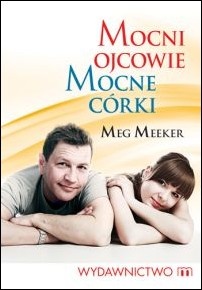Najważniejszy mężczyzna
Wydawnictwo M
Meg Meeker: Mocni ojcowie, mocne córki
Masz wpływ na całe jej życie, ponieważ ona daje takie prawo tylko tobie – i żadnemu innemu mężczyźnie na świecie. Fragment książki "Mocni ojcowie, mocne córki" publikujemy za zgodą wydawnictwa M.
Przypisy
- Amerykański system szkolnictwa, do którego odniesienia pojawiają się w całym tekście niniejszej książki, jest bardzo złożony i dodatkowo rożni się w zależności od stanu. W przybliżeniu jest on nieco podobny do polskiego: szkoła podstawowa zaczyna się w wieku 6-7 lat i trwa 5-6 lat. Dalej następuje szkoła średnia (ang. Middle School lub Junior High School), która trwa 3 lata, a następnie 3–4-letni odpowiednik naszego liceum, określany jako szkoła wyższa (ang. High School lub Senior High School). Stąd też często Amerykanie operują numerem klasy (1–12), do której chodzi dziecko. Wszyscy uczniowie kończą jednakże te szkoły i mogą rozpocząć naukę na uniwersytecie lub w tzw. college’u w jednakowym dla wszystkich wieku 18 lat (przyp. tłum.).
- W Polsce: klasy pierwszej licealnej (przyp. tłum.).
- W Polsce: klasy trzeciej licealnej (przyp. tłum.).
- Guidelines for comprehensive sexuality education, The Sexuality Information and Education Council of the United States, 2004. Podano wg: http://www.siecus.org/pubs/guidelines/guidelines.pdf, 51–66.
- Sex on TV 4, Kaiser Family Foundation, 2005. Podano wg: www.kaiserfamilyfoundation.org/entmedia/upload/sex-on/TV-4-Executive-Summary.pdf.
- Tamże.
- Dane dotyczą oczywiście dzieci i młodzieży wUSA (przyp. tłum.).
- D.T. Fleming et al., Herpes Simplex Virus Type 2 in the United States, 1976 to 1994, „New England Journal of Medicine” 337 (1997), 1105–1160.
- Tamże, 5.
- Surveillance Summary, „Morbidity & Mortality Weekly Review” 53 (21 maja 2004).
- Margaret J. Blythe et al., Incidence and Correlates of Unwanted Sex in Relationships of Middle and Late Adolescent Women, „Archives of Pediatric & Adolescent Medicine” 160 (2006), 591–595.
- Meg Meeker, Epidemic: How Teen Sex Is Killing Our Kids, Washington, DC, LifeLine Press, 2002, 154–155.
- Tamże.
- Surveillance Summary, „Morbidity & Mortality Weekly Review” 53, 17.
- American Social Health Association, Sexually Transmitted Diseases in America: How Many Cases and at What Cost?, Menlo Park, CA, Kaiser Family Foundation, 1998.
- J.M. Walboomers et al., Human Papillomavirus Is a Necessary Cause of Invasive Cervical Cancer WorldWide, „Journal of Pathology” 189 (1999), 12–19.
- Bosch et al., Effect of oral contraceptives on risk of cervical cancer in women with the human papilloma virus infection: the IARC multicentric case-control study, International Agency of Research on Cancer.
- Fleming et al., Herpes Simplex Virus Type 2 in the United States, 1976–1994.
- http://medinstitute.org/includes/downloads/herpes/pdf">http://medinstitute.org/includes/downloads/herpes/pdf
- Surveillance Summary, „Morbidity & Mortality Weekly Review” 53, 8–16.
- Denise Hallfords, Which Comes First in Adolescence: Sex and Drugs or Depression?, „American Journal of Preventive Medicine” 29 (2005), 3.
- Surveillance Summary, „Morbidity & Mortality Weekly Review” 53, 9.
- Tamże, 16.
- Tamże, 12.
- Tamże.
- Tamże.
- Tamże.
- Tamże.
- Generation M: Media in the Lives of 8–18 Year-Olds, Kaiser Family Foundation, marzec 2005. Zob. takŻe: http://www.kaiserfamilyfoundation.org/entmedia/upload/Executive-Summary-Generation-M-Media-in-the-lives-of-8-18-Year-olds.pdf.
- Tamże, 23.
- Tamże, 12.
- Tamże, 25.
- Tamże.
- Tamże.
- Tamże.
- M. Esterbrooks, Wendy A. Goldberg, Toddler Development in the Family: Impact of Father Involvement and Parenting Characteristics, „Child Development” 55 (1984), 740–752.
- E.A. Pedersen et al., Parent-Infant and Husband-Wife Interactions Observed at Five Months, w: The Father-Infant Relationship, New York, red. F. Pedersen, 1980, 65–91.
- Tamże; Rebekah Levine Coley, Children’s Socialization Experiences and Functioning in Single-Mother Households: The Importance of Fathers and Other Men, „Child Development” 69 (luty 1998), 219–230.
- Coley, Children’s Socialization Experiences and Functioning in Single-Mother Households.
- A. Morcoen, K. Verschuren, Representation of self and socioemotional competence in kindergartens: differential and combined effects of attachment to mother and father, „Child Development” 70 (1999), 183–201.
- „Journal of the American Medical Association” 10 (10 września 1999), 823–832.
- Tamże.
- „American Journal of Preventive Medicine” 1 (30 stycznia 2006), 69–66.
- U.S. Department of Health and Human Services, National Center for Health Statistics, Survey of Child Health, Washington D.C., GPO, 1993.
- Greg J. Duncan, Martha Hill, W. Jean Yeung, Fathers’ Activities and Children’s Attainments, artykuł przedstawiony na konferencji nt. zaangażowania ojców, 10–11 października, Washington D.C. Podano wg: Wade F. Horn, Tom Sylvester, Father Facts 4, www.fatherhood.org.
- Tamże.
- Harris Goldstein, Father’s absence and cognitive development of 12–17 year-olds, „Psychological Reports” 51 (1982), 843–848.
- YMCA 200. Strong Families’ Survey. Badanie telefoniczne przeprowadzone w dn. 7-9 grudnia 1999 przez Global Strategy Group of New York City dla YMCA, USA.
- Joseph E. Schwartz et al., Sociodemographic and psychosocial factors in childhood as predictors of adult mortality, „American Journal of Public Health” 85 (1995), 1237–1245.
- Claudette Wassil-Grimm, Where’s Daddy? How divorced, single and widowed mothers can provide what’s missing when dad’s missing, New York, Overlook Press, 1994.
- Henry Biller, Fathers and Families: Parental factors in child development, Westport, CT, Greenwood Publishing Group, Inc., 1993.
- Lee Smith, The new welfare of illegitimacy, „Fortune”, kwiecień 1994, 81–94.
- Mark Clemens, „Parade”, 2 lutego 1997; E.M. Hetherington, B. Martin, Family Interaction, „Psychopathological Disorders of Childhood”, New York, John Wiley and Sons, 1979, 247–302.
- Hetherington, Martin, Family Interaction.
- Tamże.
- N. Zill, Carol Schoenborn, Child development, learning and emotional problems: Health of our nation’s children, U.S. Department of Health and Human Services, National Center for Health Statistics, Advance Data 1990, Washington D.C., GPO, 1990.
- Hetherington, Martin, Family Interaction.
- Richard Koestner, Carol Franz, Joel Weinberger, The family origins of emphatic concern: A twenty-six-year longitudinal study, „Journal of Personality and Social Psychology” 58 (1990), 709–717.
- 59 Wade F. Horn, Tom Sylvester, Father Facts, Gaithersburg, MD, National Fatherhood Initiative, 2002.
- Tamże.
- C.D. Ryff, M.M. Seltzer, The Parental Experience in Midlife, Chicago, University of Chicago Press, 1996.
- Ivy League (dosł. Liga Bluszczowa) – zał. w 1954 r. stowarzyszenie ośmiu elitarnych uniwersytetów amerykańskich w północno-wschodniej części USA. Nazwa pochodzi od bluszczu typowego dla starych budynków. Są to: Brown University w Providence w stanie Rhode Island, Columbia University w Nowym Jorku, Cornell University w Ithaca w stanie Nowy Jork, Dartmouth College w Hanover w stanie New Hampshire, Harvard University w Cambridge w stanie Massachusetts, University of Pennsylvania w Filadelfii, Princeton University w stanie New Jersey oraz Yale University w New Haven w stanie Connecticut (przyp. tłum.).
aktualna ocena | |
głosujących | |
 Ocena |
bardzo słabe |
słabe |
średnie |
dobre |
super |
Ocena |
bardzo słabe |
słabe |
średnie |
dobre |
super |
WAŻNE DLA RODZINY
- Iść przez życie solo czy z rodziną?
- Pełna zgoda
- W maju rusza akcja Dzieci Komunijne Dzieciom Misji
- Od poniedziałku zmiany w "Czystym Powietrzu", dotyczące m.in. pomp ciepła
- Duda: Aborcja to temat zastępczy, świetny na kampanię
- W niedzielę Narodowy Marsz Życia
- Mocne wystąpienie Kariny Bosak w debacie nt. aborcji
- Wierni testamentowi św. Jana Pawła II
- Biskupi Europy: aborcja nigdy nie będzie prawem podstawowym
- Rodzina przyszłości: bez rodzeństwa i kuzynostwa, tylko starsi bliscy?
- Prezydent zawetował nowelizację Prawa farmaceutycznego dotyczącą tabletki "dzień po"
- Zostań najlepszym Tatą! – przegląd wspólnot i inicjatyw ojcowskich
- W czwartek weszły w życie przepisy dotyczące konfiskaty aut nietrzeźwym kierowcom
- MF: zerowy VAT na żywność nie będzie przedłużony po 31 marca br.
- Zmuszanie szpitali do dokonywania aborcji jest wbrew orzeczeniu Trybunału Konstytucyjnego z 2015 r.









